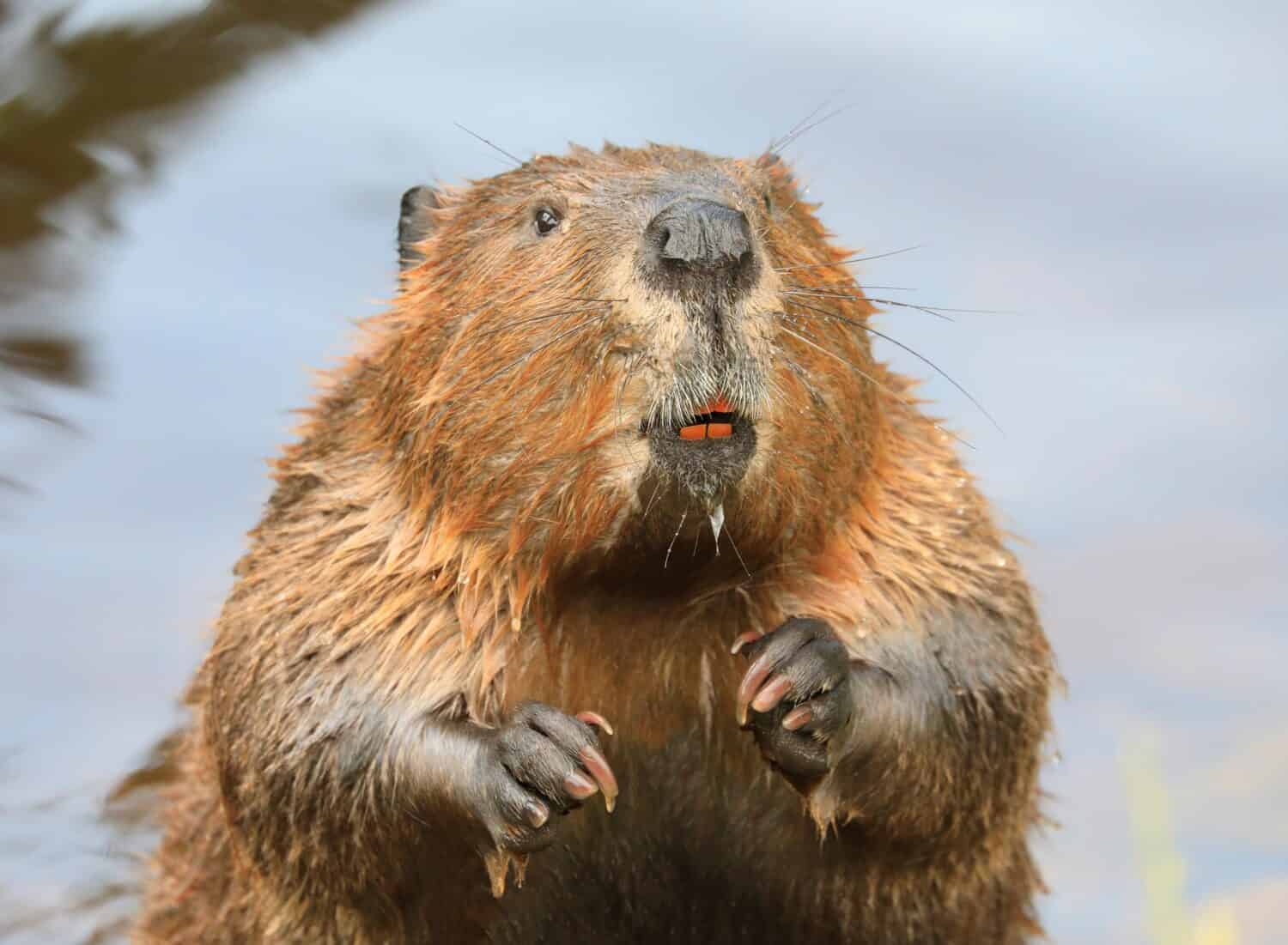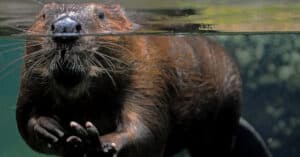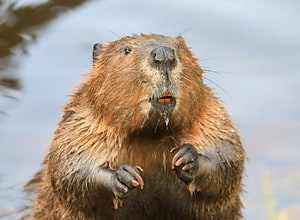We all know that beavers build dams. After all, they’re beavers, nature’s hydrologic engineers. But most of us don’t know the many reasons beavers build dams and how their activities affect the wider ecosystem. Maybe even beavers don’t know why they build dams. And it’s unlikely that they know how their actions impact the wider ecosystem. But it’s undeniable that beaver dams are a natural marvel and reminder of how life, water, land, and air, are all connected. Here, we pile on the branches and piece together 10 reasons why beavers build dams and why it matters.

Like an irresistibly catchy tune, the sound of flowing water gets beavers moving. Pictured here are the catchy rapids of the Powder River in eastern Oregon.
©Jesse Stephens/iStock via Getty Images
1. Triggered by Sound: Beavers as Instinctive Dam Builders
The mechanism that propels beavers to build is fascinating and uncanny in its intensity. Like an irresistible urge hardwired into their brains, the sound of running water sends them into a construction frenzy. It’s as if nature has instilled in them a riverine blueprint that guides their mud-caked paws to gather stones and timber, aligning them with meticulous precision.
This design etched deep in their genetic code remains a mystery to us. However, we do know that the dams they create are marvels of natural engineering. They’re designed to reduce the water’s flow, create ponds, and provide access to food and safety from predators.

Compared to most other animals, beavers homes are quite palatial.
©Norikko/Shutterstock.com
2. Dam-Building as Beaver Habitat Creation
Survival is a constant adaptation to challenges, dangers, and shifting circumstances. The dams beavers create produce deep water pools, perfect for constructing their lodges. Surrounded by water, these lodges are nearly impervious to predators like wolves, coyotes, and bears, while offering an environment tailor-made for a beaver’s needs.
The multifunctionality of beavers’ dams extends far beyond personal shelter. They are a haven in the truest sense, providing a refuge during harsh winter months by enabling food storage in the muddy bottoms of their ponds. These aquatic fortresses also act as navigational highways, allowing beavers to travel safely through flooded areas, all the while keeping them hidden from the ever-watchful eyes of predators.

Winter is coming and beavers know it and always plan accordingly.
©iStock.com/904574778
3. Winter Food Storage
When winter turns rivers into icy pathways and forests into frozen wonderlands, the beaver is already well-prepared. It’s not just the walls of their lodges or the water-guarded gates that ensure their survival. It’s also the foresight to prepare for the unforgiving months ahead. This practice might seem simple, yet it’s a strategic survival mechanism that reveals a profound understanding of their surroundings. Here’s how it unfolds:
Selection of Food
Throughout the warmer months, beavers gather branches and logs, focusing on the bark which serves as their primary food source. These natural engineers choose their winter stores with the precision of a gourmet chef, preferring certain types of trees like aspen, willow, and birch.
Storing Underwater
Once selected, the beavers place their food cache in the mud at the bottom of the pond near their lodges. This underwater pantry is not merely a hiding place but a meticulously planned storage system. Cold water acts as a natural refrigerator, preserving the freshness of the wood.
Accessibility
Throughout the winter, when the ice may form a solid layer over the pond, beavers can still access their submerged larder. Their lodges often have underwater entrances, allowing them to swim out to their cache even in the most frigid conditions.
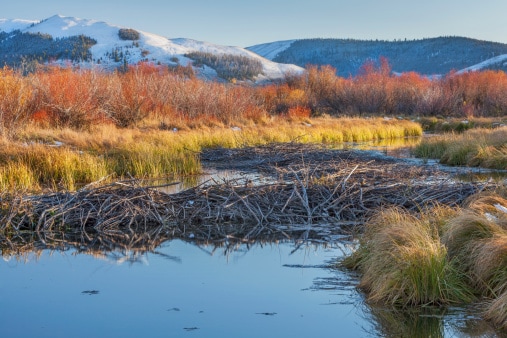
Beaver dams create underwater passages that keep them safe from predators.
©marekuliasz/ via Getty Images
4. Safe Navigation Networks
Their pond environment becomes not just a home, but a network of safe corridors through which they navigate their world. Tail and webbed feet propel them efficiently, turning waterways into protected highways. In this aquatic domain, they are sheltered from the predators that stalk the land.
This reliance on water for safe navigation is more than a mere adaptation. It’s a complex and intentional manipulation of the environment. These waterways facilitate everything from daily foraging to seasonal migrations, allowing beavers to thrive in environments where others might struggle. Not unlike humans, they rely on their strengths in the realm of environment manipulation to make up for what they lack in brute strength.
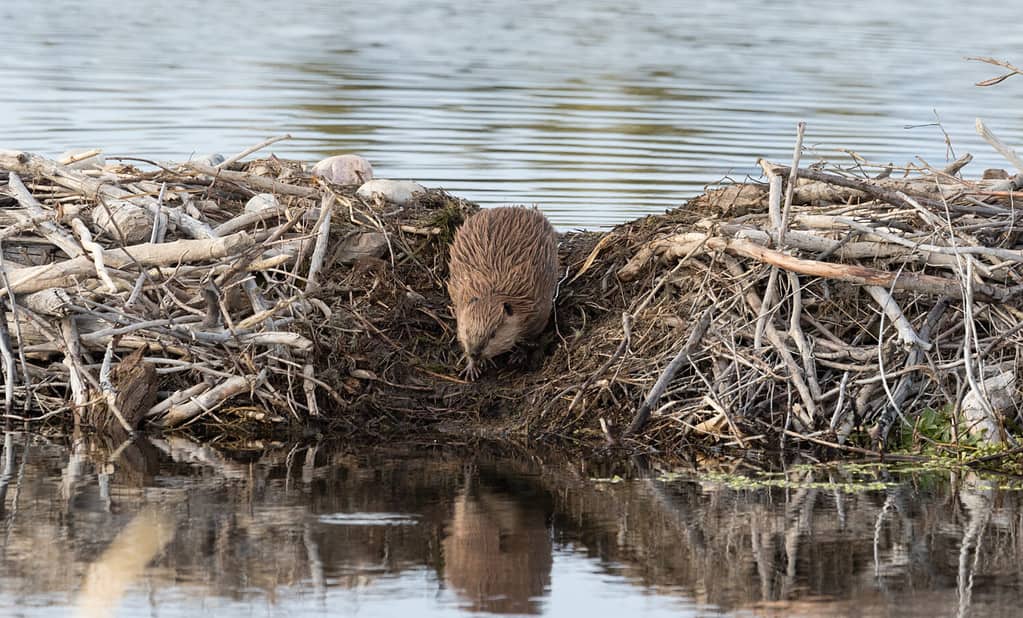
Beaver dams are huge undertakings that can hold back massive amounts of water.
©Ronnie Howard/Shutterstock.com
5. Ecological Impact of Beaver Dams
Beavers transform landscapes in ways that benefit beavers, nature, and humanity alike. Often referred to as Water Filtration Wizards, their dams act as nature’s water treatment plants. By slowing down water, they allow silt and other particulates to settle, purifying the water that flows downstream. This seemingly simple process has far-reaching effects, contributing to cleaner water supplies and healthier aquatic ecosystems.
But it’s not just the beavers who benefit. These dams create extensive wetland systems that hold and filter water, helping to prevent erosion and keeping rivers and streams healthy. Further, these wetlands act as natural firebreaks and can be critical in providing protection against wildfires. This is a precious gift in an era when such fires have become more frequent and devastating.

In much the same way that waterfalls and geological formations create pools within rivers, beaver dams slow the flow of water and give more fragile life a chance to thrive. Pictured here is Big Falls in Troy, Vermont.
©Josh Conover/Shutterstock.com
6. Beavers as Non-Beaver Habitat Creators
When beavers build a dam, they are not merely constructing a shelter for themselves. They are also laying the foundation for an entire ecosystem. The ponds and wetlands crafted by their industrious efforts become vibrant pockets of life, thriving with diversity and interconnection. It’s like a city in the wilderness, with each dam serving as a community hub where various forms of life interact with each other. Perhaps they know deep down that their existence depends on this wider web of life. Or perhaps it’s a happy coincidence.
Whatever the case, within these wetland havens, fish find shelter and breeding grounds, benefiting from the slower water flow and increased vegetation. Birds nest on the banks, dipping into the water for food and raising their young in the safety of the reeds. Insects buzz over the water’s surface, a vital food source for amphibians and other species. Mammals, both large and small, make their homes near these water bodies, capitalizing on the abundant food and water resources. These wetlands even serve as nurseries for many species, providing the safety and nourishment needed for young to grow.

In addition to beavers eating the wood and building dams with it, clearing patches of forest opens the space to sunlight, thus transforming the forest.
©Buddy-Girl Designs/ via Getty Images
7. Forest Transformers, More Than Meets the Pelt
Even if the beavers’ instincts to build dams is rooted in survival, it’s hard to deny that it’s also a creative force that shapes and reshapes the natural world. Beyond the water, when beavers gnaw at trees for construction materials, the effect is a localized transformation, like breaking ground for a new building. Though it might seem like deforestation, this change is more of a positive transformation. By felling trees, they alter the landscape, opening spaces for sunlight to reach the forest floor, fostering new growth, and inviting different species to inhabit the area.
This transformation is part of a complex and nuanced cycle of frequent disturbance that ranges from dam building and plant browsing to dam failure and abandonment. Each phase in this cycle exerts influence over channel dynamics, water flow, and various environmental aspects. It’s a process that cascades with beneficial effects. However, understanding these processes is still a work in progress. Further modeling work is needed, particularly in understanding the downstream hydrological effects of beaver dams.
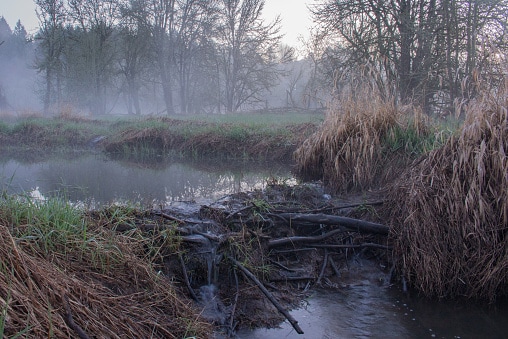
Like speed bumps for river water, beaver dams help keep high waters at bay.
©jcsandco/ via Getty Images
8. Natural Flood Control, the Beaver Way
Beavers play an important role in flood management. By building dams across streams and rivers, they create barriers to fast-flowing water. These strategically constructed networks help absorb and divert water, reducing the force and speed with which it flows downstream.
As a knock-on effect of slowing down the water, beaver dams minimize soil erosion, preserving the integrity of riverbanks and preventing the loss of valuable topsoil. This contributes to a healthier landscape, maintaining the fertility and structure of the soil. Also, these dams act as natural flood control systems. They create buffer zones that can absorb excess water during heavy rainfalls or rapid snow melts, reducing the risk of floods in certain areas.

In addition to being early environmentalists, beavers were early adopters of monogamy, as they mate for life.
©Telly/Shutterstock.com
9. Beaver Dams as Climate Change Mitigators
In the complex battle against climate change, beavers are emerging as unsung heroes, wielding a surprising and powerful tool: their dams. Though the beavers may not know it, their dams create wetland habitats that act as carbon sinks, trapping and sequestering carbon dioxide from the atmosphere. This places beavers at the forefront of natural climate change mitigation strategies, turning their habitats into buffers against global warming.
But the beaver’s role doesn’t stop there. Their dams also raise upstream water levels, directing water into nearby soils and secondary streams known as riparian zones. These zones function like nature’s filters, straining out excess nutrients and contaminants, improving water quality, and providing resilience against climate change’s extreme effects. As the understanding of beaver dams’ positive counter to climate change grows, so does the recognition of their importance. Research from Stanford University suggests that the influence of beavers on water quality and climate resilience may even intensify as the planet continues to warm.
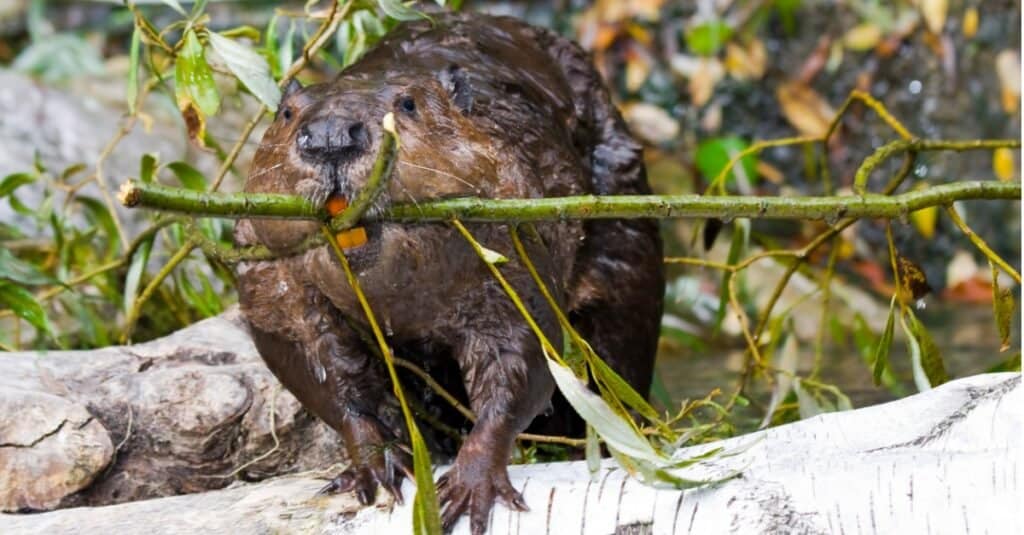
Despite their webbed paws that lack thumbs, beavers will build and build and build.
©iStock.com/belizar73
10. Ecosystem Engineers
Beavers don’t just build; they are also good stewards of their environment. They are constantly maintaining and repairing their dams. This persistent engineering work reflects an intricate balance between instinct and environmental adaptation, where every stick placed, and mud patch applied, ensures the stability and functionality of their habitat. In this way they foster an entire ecosystem, where water is slowed, filtered, and controlled in a way that supports a thriving community of plants and animals. It’s almost as if we could learn something from these wonderful creatures.
Conclusion
Beavers’ dam-building frenzying goes beyond mere instinct. It’s a complex mix of survival needs, ecological influence, and climate change mitigation (insofar as they are adapting to the environment and responding to shifts in it). These structures are not just home base for beaverkind. Being so much more, they shape landscapes and support various species, including humans. Understanding why beavers build dams and the effects they have on the wider world is nothing short of awe-inspiring and reminds us that humans are not alone when it comes to tackling global warming.
Thank you for reading! Have some feedback for us? Contact the AZ Animals editorial team.

